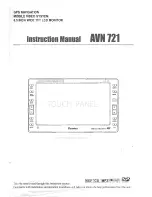
OPERATOR’S
MANUAL
CMA-9000 FLIGHT MANAGEMENT SYSTEM
Page
7-22
November 19, 2009
SECTION 7-2
VERTICAL NAVIGATION
GENERAL
This section applies to those aircraft installations where the FMS is configured for VNAV. Refer to AFMS for
further details.
Current CMA-9000 FMS implementation supports a VNAV Approach mode. The Vertical Navigation (VNAV)
function provides
advisory geometric
vertical guidance on the HSI glideslope scale and is
not coupled
to the
autopilot/flight-director system. An invalid condition for VNAV will bring the glideslope flag in-view and prevent
display of misleading information.
CAUTION:
When the VNAV approach function is utilised during non-precision approaches, it is
mandatory
for
the crew to have the VNAV approach page displayed on the CMA-9000 Display Panel.
In all instances, the altimeter
MUST
remain the primary altitude source for the crew.
VNAV APPROACH MODE
Within the terminal area, the FMS provides airplane vertical deviation advisory information, with respect to a
path projected backward at a specified vertical path angle (VPA) from the runway threshold crossing height
(TCH) and passing through the final approach fix (FAF). For vertical profile view, refer to Figure 7-3. Laterally,
the glidepath is centered on the final approach course with its width limited to +/- 6.0 nm inbound to FAF and
limited to +/- 0.6 nm from FAF up to the runway threshold. If the aircraft position is outside this zone defining
the glidepath width, or if the aircraft is not inbound to the landing runway vertical deviation advisory information
will not be provided (e.g. glideslope pointer will be biased out-of-view). For plan view, refer to Figure 7-4.
NOTE: FMS must be in GPS NAV mode for display of vertical deviation information.
If the selected approach name (as it appears on the VNAV page title) does not include a runway
number (e.g. 19L), then the VNAV glidepath calculation cannot be activated since the approach does
not have an associated runway threshold.
The glidepath will automatically be activated upon entering the terminal area, provided the aircraft is positioned
within the zone defining the glidepath width as described above.
When the glidepath is activated, the deviation from the vertical path is being actively computed and displayed on
the HSI/ADI depending on the installation.
The FMS can be configured for temperature compensation. The compensation may be required for destination
airport temperature conditions deviating from the ISA temperature. When configured a system alert message,
"SET AIRPORT TEMP" will be displayed in the scratchpad when the aircraft enters the terminal area. If the
airport temperature is entered into the FMS, the vertical deviation information will include temperature
compensation.
This page is printed under user's responsibility
and must not be retained for reference
















































